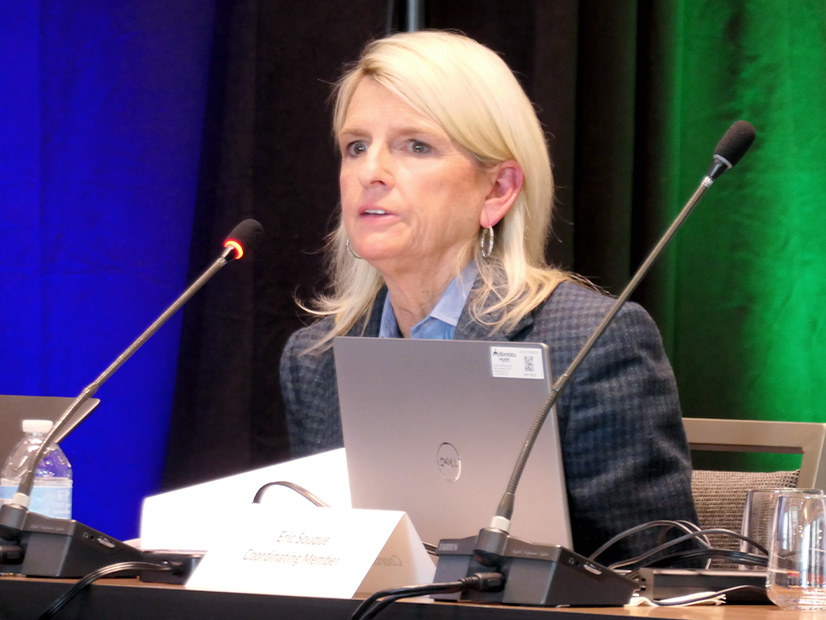DALLAS — MISO members appeared skeptical at their quarterly meetings that the RTO is destined to face capacity shortfalls before 2030.
MISO Advisory Committee members at a March 20 meeting cast doubt on predicted shortcomings from both NERC’s 2023 Long-Term Reliability Assessment and MISO’s latest version of its Reliability Imperative report.
MISO was elevated to a high-risk area by NERC late last year; the agency predicted the footprint would grapple with a 4.7-GW shortfall by 2028.
And last month, MISO warned that members are powering down dispatchable units too quickly and aren’t building equivalent generation able to pick up the slack on the grid. (See MISO Publishes Call to Action to Bypass Danger in Reliability Imperative Report.)
Minnesota Public Utilities Commissioner Joseph Sullivan said capacity shortages projected in NERC reports haven’t transpired, while some regions previously designated as low risk have experienced blackouts. He said state commissions and utilities have cooperated to delay retirements and ensure resource plans are sufficient.
The Michigan Public Service Commission on March 15 cited resource adequacy worries when it rejected Consumers Energy’s early termination requests on two power purchase agreements with biomass plants. The commission said that “relying on unpredictable markets for replacement supply outside of a comprehensive integrated resource planning process in this manner entailed an unacceptable level of risk.”
Sullivan also said the Organization of MISO States and MISO’s annual RA survey “affords more context and granularity” than NERC reports.
The Union of Concerned Scientists’ Sam Gomberg agreed that states historically have kept the lights on and that NERC’s projected shortfalls haven’t emerged.
“I think there’s a lot of reactionary effect when we see our region in red. But it’s NERC’s job to keep these fires lit. … This is not to obviate the sense of urgency,” Gomberg said. “I want to emphasize the role of the states.” He said he had faith that states will help MISO “get over the hump” of turbulent years of thermal retirements and replacement with clean power sources. He also said NERC’s report seemed flawed because it relies on a drop in resource additions by 2028.
Gomberg also said he noticed MISO is working on several initiatives NERC suggested.
“Perhaps the sky is not falling, but it does help emphasize to regulators that our plans in place are working,” WEC Energy Group’s Chris Plante said.
But Michelle Bloodworth, of coal trade organization America’s Power, said it’s well known that solar and wind generation cannot provide the six operating attributes MISO has singled out as critical to the system. She said the premature retirement of mostly coal resources is connected directly to the reliability crisis.
MISO has defined six system reliability attributes as vital to the system, including availability, rapid start times, the ability to deliver long-duration energy at a high output, and providing voltage stability, ramp-up capability and fuel supply certainty. (See MISO: Attributes Work Won’t Result in New Obligations on Retirements, Interconnection Queue.)
Bloodworth said it’s a wake-up call that NERC raised MISO from “elevated” to “high risk” in its latest assessment. She advised MISO to be “cautious about any thermal generation that is retiring, not just coal.”
Clean Grid Alliance’s Beth Soholt said both the NERC Long-Term Reliability Assessment and MISO’s Reliability Imperative struck an unnecessarily catastrophic tone.
“I think our sector would rather have a tone of ‘this is what needs to be done’ rather than ‘the sky is falling’ alarmist [rhetoric],” she said.
Soholt also said MISO and states could do more to make sure energy storage can serve as a source of dispatchable power in the fleet transition.
However, Bloodworth said she commended the “sober” tone because there is cause for concern, with 19 GW of MISO’s coal fleet set to retire in the next five years and even new natural gas investment threatened by EPA’s proposed carbon emissions rule.
“A megawatt is only as good as the people it’s delivered to,” Bloodworth said.
Gomberg said coal use is “devastating from the cradle to the grave” in terms of toxic environmental and deadly public health consequences.
“The quicker we can move on from coal, the better,” he said.
Yvonne Cappel-Vickery, the clean energy organizer for the Alliance for Affordable Energy, said it would be helpful if utilities were more open with customers about their resource plans.
Travis Stewart, representing the Coalition of Midwest Power Producers, said in addition to new resources, MISO needs new transmission, especially merchant HVDC lines.
“You can read that same headline for the past 10 years,” OMS Executive Director Marcus Hawkins said weeks earlier about MISO and NERC warning about a pending shortfall in the next three to four years.
But state regulators are working relentlessly to ensure that “MISO’s worst nightmare doesn’t come true,” Hawkins said at the Gulf Coast Power Association’s March MISO-SPP conference. However, Hawkins said new load growth and the hastening fleet transition means different factors are at play in estimating capacity adequacy.
“We’ve had quite an erosion in our resource adequacy,” MISO CEO John Bear told board members and stakeholders at MISO’s March 21 board meeting.
Bear said the grid operator is going to have to ensure it conducts sufficient analysis to be confident in its decisions’ safety before moving ahead on more RA initiatives. Nevertheless, he said, moving ahead is a must.
Bear predicted MISO won’t have glowing news to share in its next RA survey due in summer in partnership with OMS. He said RA concerns are compounded by significant load additions across the footprint and system stability concerns.
“I want to remind people, as we move forward, there are going to be very new risks,” Bear said.
Iowa Utilities Board member and OMS President Josh Byrnes agreed the RA risks are real, and the solutions are complex; however, he urged fellow commissioners and members to “stay positive.”



